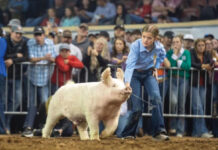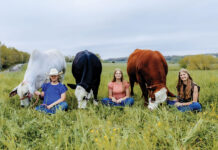Brad and Bob Thompson and families of Vernon County, Mo., chose Red Angus because they liked the breed and its advantages and wanted something a little different.
“Registered Red Angus were not very prevalent at the time, but we found a herd for sale in St. Francis, Kan.,” Brad said. “We purchased the herd in 1992 and raised bulls and replacement females for 12 years and then made the decision to go commercial and have remained so since that time.”
Angus were introduced into America in 1873 in Victoria, Kan., and soon gained in popularity. In 1890, twenty-two reds were registered in the American Angus Herd book of some 2,700 individuals entered that year. In 1945, various cattlemen throughout the United States started selecting and breeding red cattle that were culled from the black Angus herds in America. In 1954, seven breeders gathered to establish a unique breeder’s organization known as the Red Angus Association of America (RAAA). Rejecting the norms of the times, the RAAA was designed around the new scientific principles of performance testing. Other firsts for the Red Angus breed include utilizing AI. Red Angus was the first to incorporate performance data in the showring, holding the first “performance” show in 1956. It was not until the 1990s that some breeds started to use objective data in the showring as an additional evaluation tool for the judge, besides the traditional visual appraisal of animals. RAAA’s founders saw crossbreeding as an opportunity to expand commercial utilization of the breed, and as early as 1961, began promoting the use of Red Angus in planned crossbreeding systems. This was approximately 10 years before the industry even started to accept crossbreeding as a tool for commercial cow/calf production. Other benefits of the Red Angus Breed include the red color. Red is the most popular color of cattle breeds worldwide, providing great crossbreeding opportunities while maintaining color. Red is heat tolerant and gives good resistance to cancer eye and sun burned udders. Red breeds true. Red Angus carry no diluter genes and thus avoid the grays that result when crossbreeding with blacks.
The Thompson Brothers’ herd is basically purebred with some crossbred cows. They utilize AI on all their heifers and at various times their cows. Bulls are picked with maternal traits as well as good carcass traits. Heifers are kept as replacements and steers are grazed and then either fed out or sold depending on market conditions.
“We have both a spring and a fall herd, both have their advantages and disadvantages,” Brad said. “Fall calvers require more feed to get nursing mothers through the winter but calving is usually under better conditions for the calves. We like to graze year-round when we can. We stock at a rate of 3.5 acres per cow and this allows us to get to January or February most years. We do supplement nursing cows with alfalfa at a rate of 5-pounds per cow, per day from calving till mid-April or whenever the grass starts to green up. They will usually tell us when it’s time to quit feeding alfalfa.”
Fall cows receive alfalfa from November till March or April. They don’t creep feed, believing in their genetics, and will pick up compensatory gain at weaning time. All pastures are fescue/legume mixes and they manage accordingly for endophyte issues. Mowing early, rotating pastures, mineral program, etc. to keep endophyte in check. They don’t bale a lot of hay, but try to minimize their labor by grazing as long as they can throughout the year.
“So, if it has a fence around it we graze it,” Brad said. “The few acres not fenced are baled on shares and that hay is used during droughts, snow/ice storms or for weaning calves. We occasionally will plant turnips or rye or wheat to graze if we have the opportunity on a nearby field.”
All cows and bulls are vaccinated and wormed twice a year, preg-checked and evaluated for condition. Any cow or bull not passing a soundness exam is removed from the herd and replaced with cattle from their replacement program. They have cows as old as 18 years still producing in their herd. Calves are preconditioned, vaccinated, castrated, and revaccinated at 21 days. They background them for 120 to 150 days and then decide whether to feed or sell based on market conditions at that time.
“We have never shown our cattle anywhere other than our local youth fair. Steers, heifers and bucket calves have been part of the family since the beginning of our herd. We have won many first-place ribbons, rate of gains, and carcass awards,” Brad said.
“We truly enjoy our Red Angus cattle and receive lots of compliments and requests for females and a return to the bull market which we are considering. We hope to pass this tradition on to the next generation.”








I thought it was interesting to read how much you enjoyed your angus cattle. I’ve been considering getting angus cattle myself. I would love to reach out to an angus bull supplier near me and see how I’ll like them.